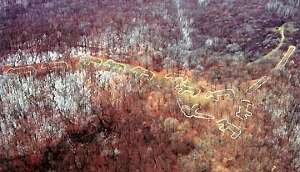
Imagine having to campaign to keep commercial businesses from building over the cemetery your grandmother is buried in. This is a struggle that many Native Americans face today. Every day, they see their culture and what their ancestors built being taken away and destroyed.
Effigy mounds are locations of burial grounds that usually have animal shapes. Some of them were used for human burial and contained personal belongings of the deceased; others were used for ceremonial purposes. Effigy mounds are unique to Wisconsin’s history. They show us the history and culture of Wisconsin before European settlers arrived.
“It's very important to make sure these are preserved, and honor why they are here, and even marvel at them,” stated Carly Lincoln, who represents the Madison area in the Ho-Chunk Nation legislature, "I'm inspired by the fact that you don't find these everywhere.”
Most of the mounds mapped by early European settlers have been destroyed. After the Native Americans were pushed off the land in the 1830s, European settlers were astonished by the sight of the effigy mounds. Rather than believe they had been built by Native Americans, who they viewed as barbarians, the settlers who discovered the effigy mounds made up stories about a superior race – a lost tribe – that had created them. Preservation attempts failed. Mounds were plowed over and looted for bones and antiques. Digging up the burial sites was a common Sunday afternoon activity, said former state archaeologist Robert Birmingham.
A primary reason that protection and funding remain an issue is that in order to receive protection, mound locations need to be evaluated and reported. When survey reports are not completed, the land is no longer protected under the law. This event leads to the effigy mounds being vulnerable to vandals and commercial use.
Effigy mounds can be found in various states in the Midwest, but the highest level of concentration is in Madison, along the banks of the Yahara River and its lakes. The area has a greater concentration of effigy mounds than any other place. The Yahara River system was home to about 160 mound groups; the largest group overlooked Lake Mendota where Sherman Avenue today approaches the Yahara River. In Dane County, there are more than 200 examples of three major types of effigy mounds in the shapes of birds, mammals, and animal spirits.
Many Native Americans believe that they are descended from animal spirits through clans and there are parallels between the effigy mound shapes and the clan structure of many tribes in the Upper Midwest.
"These were symbols of who we were, and our current clan system identifies all of them," states Jon Greendeer, Ho-Chunk executive director of heritage preservation.
The effigy mounds were built from around 700 A.D. to 1100 A.D. During those 400 years, mound building increased due to increased prosperity. Then, abruptly, mound building stopped.
No one knows exactly why the mounds were built and why their construction stopped suddenly nearly 1,000 years ago. According to anthropologists, some things are known; mounds were used as burial markers and contained great ceremonial, sacred, and spiritual significance for the native people. The vast amount of mounds in the Yahara Lakes region indicates that they were connected to the water in some way. According to Amy Rosebrough, an archaeologist for the Wisconsin historic preservation office, “very, very few are not near a lake or river, and then often there are springs nearby.”
While the mystery surrounding the mounds is intriguing, it is clear that Madison was a special place for the mound-builders. Native mounds can be found all over southern Wisconsin, but the greatest level of activity was centered at Yahara Lakes. The historical significance of the mounds is an important part of Wisconsin’s history and culture and unique to our state.
[Sources:
Wisconsin State Journal
;
Wisconsin Historical Society
]

